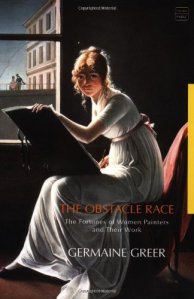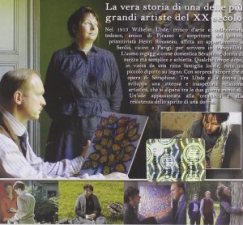 December
11
December
11
Tags
Art and Insanity: Séraphine Louis, Naïve Genius
 On the 11th of December 1942, a naïve painter, Séraphine Louis, also known as “Séraphine de Senlis“, died in a Villers-sous-Erquery hospital in northern France, although according to her mentor, Wilhelm Uhde, she died at Clermont’s lunatic asylum in 1934. It is questionable then whether Uhde wanted to withdraw from being associated with the mentally ill painter or he simply did it to round up the story of her life to a reasonably respectful ending.
On the 11th of December 1942, a naïve painter, Séraphine Louis, also known as “Séraphine de Senlis“, died in a Villers-sous-Erquery hospital in northern France, although according to her mentor, Wilhelm Uhde, she died at Clermont’s lunatic asylum in 1934. It is questionable then whether Uhde wanted to withdraw from being associated with the mentally ill painter or he simply did it to round up the story of her life to a reasonably respectful ending.
Séraphine Luis was a poor and simple woman. Born in 1864 to a family of labourers, she was orphaned at the age of seven. She was then taken care of by her older sister and from early childhood worked as a shepherdess. Later on in her life she was employed as a servant to middle-class families in the town of Senlis. One of the households she worked in was that one of the German collector of primitive paintings Wilhelm Uhde, who stood behind the successes of such painters as Henri Rousseau, André Bauchant, Camille Bombois and Louis Vivin. In 1912, Uhde spotted Séraphine’s captivating talent for painting. “He saw a still-life of apples in a neighbour’s house and was astonished to discover that Séraphine was the artist. He supplied her with the materials that she had never had and encouraged her to paint until the war drove him out of France. When he returned, he did not scruple to collect all of Séraphine’s work, as if she had been under contract to him. Her first exhibition was held at the Galerie des Quatre Chemins in 1927.” (Germaine Greer, The Obstacle Race: The Fortunes of Women Painters and Their Work).
 Séraphine created most of her paintings locked in her small room, lit by candlelight and with the image of the Blessed Virgin looking down on her. Untaught, and following what she regarded as religious inspiration, she produced elaborate floral designs. “Some of her flowers look as if they belonged to the flesh-consuming kind. Flame-like or hairy and prickly, they cover her canvases like growths that cannot be stopped, and malicious eyes are hidden among the leaves. The colours are often murky, and sometimes there is no composition but uncontrolled accumulation. Among flower-pieces these paintings are unique, for they express fierceness rather than a lyrical temperament. Undoubtedly Séraphine had reached the borderline of insanity when she painted them.” (Edith Hoffmann, Naïve Painters in Rotterdam and Paris, The Burlington Magazine, Vol. 106, No. 739, Oct. 1964).
Séraphine created most of her paintings locked in her small room, lit by candlelight and with the image of the Blessed Virgin looking down on her. Untaught, and following what she regarded as religious inspiration, she produced elaborate floral designs. “Some of her flowers look as if they belonged to the flesh-consuming kind. Flame-like or hairy and prickly, they cover her canvases like growths that cannot be stopped, and malicious eyes are hidden among the leaves. The colours are often murky, and sometimes there is no composition but uncontrolled accumulation. Among flower-pieces these paintings are unique, for they express fierceness rather than a lyrical temperament. Undoubtedly Séraphine had reached the borderline of insanity when she painted them.” (Edith Hoffmann, Naïve Painters in Rotterdam and Paris, The Burlington Magazine, Vol. 106, No. 739, Oct. 1964).
In 1929, after the exhibition Painters of the Sacred Heart, organised by Uhde, Séraphine experienced the joy of having money for the first time in her life. Unfortunately, her financial security was not destined to last very long. In 1930, due to the effects of the Great Depression, Uhde could no longer pay for Séraphine’s works. It seems that this episode of financial success was the major cause of her mental breakdown. The visions of rich and comfortable life perturbed her simple mind to the point where she was no longer able to paint. The genius was lost there and then.
The story of the painter’s life was depicted in a 2008 French and Belgian biopic, Séraphine (dir. Martin Provost). The leading role, played by Yolande Moreau, brings justice to Séraphine’s turbulent life. According to Xan Brooks of The Guardian, “…played by Yolande Moreau, Séraphine looks positively monolithic – a round-shouldered, splay-footed creature of toil. But her mental state is precarious, propped up by familiar routines. Success unbalances her and she takes to wandering the streets, resplendent in a new, shop-bought wedding dress. Provost unearths this marginal figure to offer a poignant salute to a life on the fringes. This is a measured, soulful and tactile work; a film with gouache beneath its fingernails. Like Maurice Pialat’s Van Gogh drama, it suggests that outsider art may be as much a symptom of disorder as a release from it. In Séraphine’s case, it is a private, personal enterprise, fitted in around the day-to-day drudgery and largely played out behind closed doors. Drag the art into the spotlight and the artist combusts.” (Xan Brooks, The Guardian, 27 November 2009).
resplendent in a new, shop-bought wedding dress. Provost unearths this marginal figure to offer a poignant salute to a life on the fringes. This is a measured, soulful and tactile work; a film with gouache beneath its fingernails. Like Maurice Pialat’s Van Gogh drama, it suggests that outsider art may be as much a symptom of disorder as a release from it. In Séraphine’s case, it is a private, personal enterprise, fitted in around the day-to-day drudgery and largely played out behind closed doors. Drag the art into the spotlight and the artist combusts.” (Xan Brooks, The Guardian, 27 November 2009).










Pingback: Controversy on painter Karel Appel | Dear Kitty. Some blog
I take huge issue with anyone who attempts to diminish a persons creative accomplishments or endeavors by what happened to the artist as a result.
often creative inspiration is a kind of madness or infestation, not a “release” from it. there is no reason to assume that “god” is a force or an entity whose condition is so entirely well known that one could or should assume that by becoming one with “him”, a person sanity should remain intact. There is nothing “outsider” about art done in private. Art is art and the quality of it isn’t reliant on a witness. Being an artist IS a kind of witness state. I should think it would be a privilege to die for ones art or to be consumed. I don’t see that it is at all rational to assume that a person who lives their life in a state of ecstasy has some huge responsibility to then prove their normalcy to others… humans in general live in a huge amount of denial about what it takes to produce things of wonder. They have a cost, a human cost. But are they still worth it?? YES.
LikeLiked by 1 person
Thank you for your insightful comment. I think it opens up a broader question on the substance of art, and whether we can and should define it at all. I don’t think that Xan Brooks from The Guardian was trying to diminish Séraphine’s creative accomplishments, but he certainly measured it according to certain formal frames established by the western art world. And probably this is something we should argue against…?
LikeLiked by 1 person
Pingback: Hans Prinzhorn: Curating the Art of Mental Illness | A R T L▼R K
Seraphine worked as Uhde’s servant in fact. Her images are particularly interesting in the botanical sense because they depict imaginary botanical species. On close examination, her work is often full of cracks….maybe because she had her own recipe for painting….
LikeLike
Reblogged this on Lenora's Culture Center and Foray into History.
LikeLike